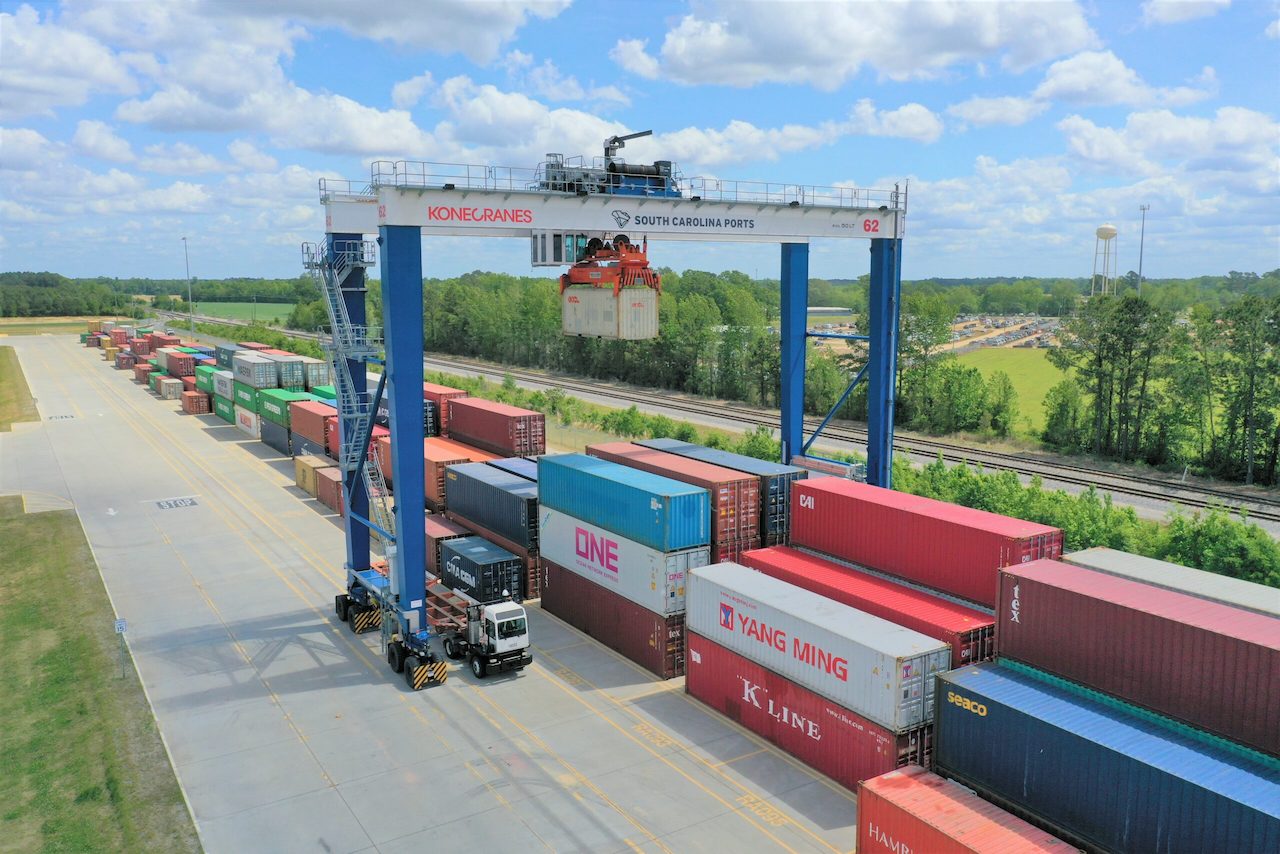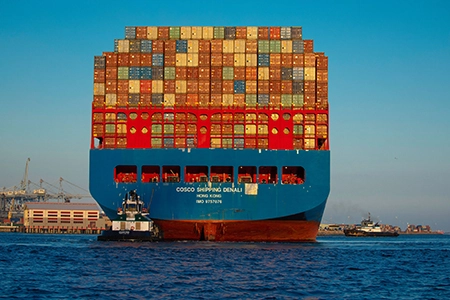
Intermodal Briefs: SC Ports, Port of Long Beach, FourKites
Written by Carolina Worrell, Senior Editor
SC Ports’ Inland Port Dillon had a record month for containers. (Photo/SCPA/Walter Lagarenne)
South Carolina (SC) Ports celebrates the five-year anniversary of Inland Port Dillon with record month for containers handled. Also, Port of Long Beach cargo slows in March; and FourKites announces new enhancements to its Sustainability Hub.
SC Ports
SC Ports announced April 18 that it is celebrating the five-year anniversary of its Inland Port Dillon with a record number of containers handled in March.
According to SC Ports, March marked the busiest month in Inland Port Dillon’s history, with more than 4,300 containers handled—a 16% increase from the previous record set in December 2022. Inland Ports Greer and Dillon handled 17,534 rail moves combined in March.
SC Ports handled 193,085 TEUs (twenty-foot equivalent units) and 107,084 pier containers in March, for a total of nearly two million TEUs and around 1.09 million pier containers handled fiscal-year-to-date. SC Ports also handled 15,692 vehicles last month.
Inland Port Dillon provides importers and exporters with a direct connection to the Port of Charleston via CSX. The operation swiftly handles goods for importers like Harbor Freight Tools and exporters like International Paper, The Anderson’s and Darling International.
According to SC Ports, the idea for Inland Port Dillon, which supports agribusiness by connecting farmers to international markets, came from seeing the success of SC Ports’ first inland port in Greer, which opened in 2013. SC Ports invested in its second inland port in Dillon, which opened in 2018 with Harbor Freight Tools as the anchor tenant. Customers such as Performance Ag, Palmetto Grain, Smithfield Grain, Northwest Grains and C&M Hog Farms also move grain and soybeans through the inland port.
“This was an innovative and cutting-edge idea at the time that few ports in the country were undertaking, but we believed strongly that SC Ports needed rail-served inland ports in South Carolina,” SC Ports President and CEO Barbara Melvin said. “We wanted to extend the Port of Charleston’s reach inland to better serve our customers.”
“We proudly move freight for South Carolina, and we are equally as proud to be a part of the Dillon community,” Melvin added. “We look forward to more growth here in the years to come.”
Port of Long Beach
The Port of Long Beach announced April 19 that trade at the Port in March declined nearly one-third from the same period last year as “retailers continue to clear warehouses and shippers shuffle routes from the West Coast to seaports on the East and Gulf coasts.”

According to the Port, dockworkers and terminal operators moved 603,878 TEUs last month, down 30% from March 2022, which was the Port of Long Beach’s busiest March on record. Imports decreased 34.7% to 279,148 TEUs while exports increased 16.9% to 133,512 TEUs. Empty containers moved through the Port declined 40.5% to 191,218 TEUs.
The Port has moved 1,721,326 TEUs during the first quarter of 2023, down 30% from the same period in 2022.
“Warehouses remain full and fewer cargo containers are crossing the docks because consumer spending remains slow,” said Port of Long Beach Executive Director Mario Cordero. “We are ready for a rebound in retail as we work with our industry partners to recapture market share.”
“We continue to invest in our infrastructure projects and look for ways to efficiently and sustainably move cargo so our customers new and old are reminded why we are the Port of Choice,” said Long Beach Harbor Commission President Sharon L. Weissman. “We will be ready when cargo volumes are on the rise again.”
Economists, according to the Port, say financial markets are starting to stabilize following fears of a banking crisis in March. Additionally, consumers spent less as income growth slowed, savings buffers declined, and credit card debt rose.
FourKites
Supply chain visibility provider FourKites on April 19 announced several new enhancements to its Sustainability Hub, which the company says are “designed to provide customers with greater ability to track, analyze and report on the environmental impact of their supply chain logistics operations.”

Introduced last March, Sustainability Hub offers “granular emissions tracking, industry benchmarks, analytics and scenario modeling to help customers meet sustainability goals.” These insights, FourKites says, are powered by the company’s network of more than 1,200 customers and 490,000 carriers, tracking more than three million daily shipments across 220 countries and territories.
FourKites’ latest sustainability capabilities include:
- More granular and accurate Scope 31 emissions calculations. FourKites now incorporates load weight into its emissions calculations to provide shippers with more accurate estimates of Scope 3 emissions across all modes. This capability, the company says, is particularly valuable for less-than-truckload and air shipments, for example, where a shipper’s freight accounts for only a fraction of a vehicle’s total load.
- SmartWay-ready data aggregation. FourKites will provide shippers and carriers with comprehensive, export-ready data for their annual reporting of efficiency and air quality performance to the EPA’s SmartWay2 program. While SmartWay rankings help shippers and carriers improve their overall performance by using more and better SmartWay Carrier Partners, the company says pulling together the data across large companies can be “arduous.” FourKites says its new capabilities “relieve customers of significant time and effort in preparing their submissions.”
- SmartWay carrier sustainability rankings will also be integrated into FourKites’ carrier onboarding tools, “seamlessly giving shippers and carriers the critical performance data they need to build a stronger, higher-performing roster of partners.”
According to the U.S. Environmental Protection Agency (EPA), organizations’ supply chains often account for more than 90% of their greenhouse gas (GHG) emissions. Moreover, FourKites says, air emissions from freight are projected to exceed growth in emissions from all other transportation activities—including passenger transportation—by 2025. The Wall Street Journal recently reported that companies worldwide are facing increased pressure from their many stakeholders to demonstrate progress against sustainability goals, but supply chain professionals need better tools, technology and cross-industry collaboration to do so.
“By using FourKites’ Sustainability Dashboard, we were able to show the EPA how we are tracking carbon emissions,” said Amy Keen, Logistics Analyst at Haworth. “The fact that we have that information at our fingertips makes things really easy. We’re also in the process of doing a global assessment of our corporate footprint, and the information we can pull now is going to be so helpful.”
In addition to its Sustainability Hub, FourKites says solutions like Dynamic Yard® and Appointment Manager can “optimize time slots and yard processes to significantly reduce on-site truck dwell time and CO2 emissions.”
“The combination of new government regulations and increased public demand for accountability has driven the need for sustainable supply chain logistics,” said FourKites Chief Product Officer Priya Rajagopalan. “We see more supply chain leaders embracing sustainability efforts as a key lever in driving more efficient and profitable businesses, and we are excited to bring them these powerful new capabilities to help them achieve their goals.”



![“This record growth [in fiscal year 2024’s third quarter] is a direct result of our innovative logistic solutions during supply chain disruptions as shippers focus on diversifying their trade lanes,” Port NOLA President and CEO and New Orleans Public Belt (NOPB) CEO Brandy D. Christian said during a May 2 announcement (Port NOLA Photograph)](https://www.railwayage.com/wp-content/uploads/2024/05/portnola-315x168.png)